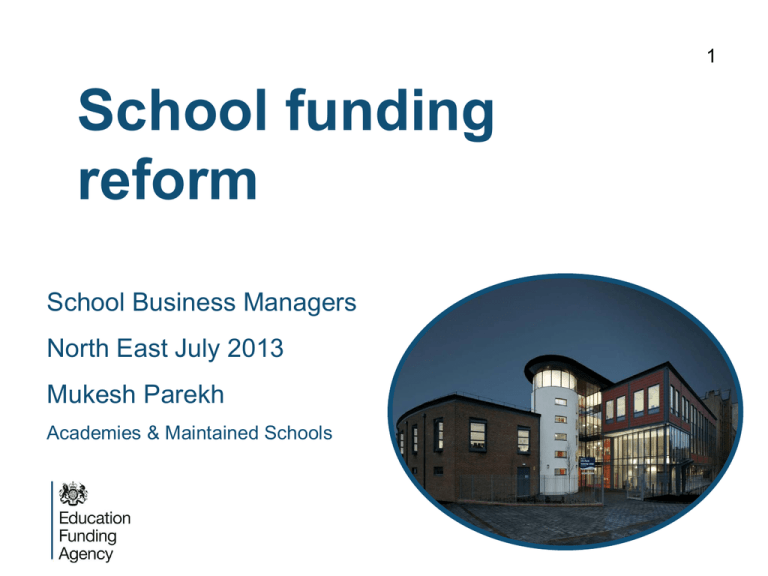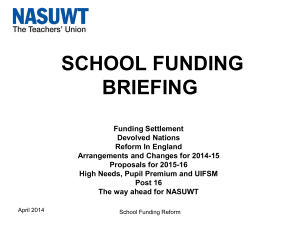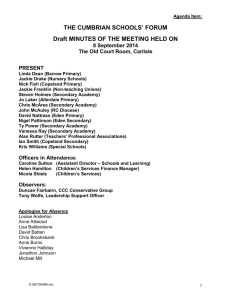EFA School funding reform
advertisement

1 School funding reform School Business Managers North East July 2013 Mukesh Parekh Academies & Maintained Schools The case for reform Previous system complex, opaque, unfair and often perverse School Funding Reform (2012): first step towards a fairer system and the national funding formula – Introduction of 12 factors for bases of calculating funding High needs: Special Educational Needs / Learners with Learning Difficulties and/or Disabilities (to age 25) funding reform Review of implementation in spring 2013 2014/15 factors announced in June 2013 How it felt for schools and academies Overly complicated Too bureaucratic Opaque Poorly communicated Prone to error and interpretation Design of the LA funding model Twelve standard factors are available for use in the local funding model Two of the factors are compulsory – basic entitlement (age weighted pupil unit or AWPU) – deprivation The other 10 factors are optional Local authorities can suggest exceptional factors The final proforma is agreed in the Schools Forum Existing 2013/14 allowable factors Basic entitlement (Compulsory) Deprivation (Compulsory) Prior attainment Looked after children English as an additional language Pupil mobility Lump sum (Max of £200K) Split sites Rates Private Finance Initiative (PFI) London fringe Post-16 Exceptional factors LA’s can include additional exceptional factors. Must have dedicated criteria and must be pre-agreed by the EFA Exceptional costs – Maximum of 5% of schools in a local area – Circumstances must have a financial impact greater than 1% of the school’s budget Minimum Funding Guarantee MFG set at -1.5% per pupil for 2013/14 & 2014/15 The following aspects excluded from protection: – – – – – Post-16 Early years High needs Lump sum Rates Local authorities could apply for additional exclusions – For example bulge classes where the money should not be built into your baseline as it will disadvantage you in subsequent years Schools Forum reform New Schools Forum regulations – Only the DCS, Chief Finance Officer and Lead member (or their deputy) can be LA members of the Schools Forum – The need for a minimum of 16 members has been removed – LA staff cannot vote on their own proposals, only the other members of the Forum – Academies are entitled to proportional representation on the Forum – EFA has observer status at meetings Schools Funding Reform Summary (Stage 1) Introduction of 12 Factors funding methodology HN funding Reformed to Planned Places plus top up funding New Schools Forum regulations Post 16 Funding Reforms Review of 2013-14 arrangements (Spring 2013) Continuing a clear commitment to reform funding systems Looked at getting views on are we moving towards national consistency Getting views, on areas of concern and possible changes Looking specifically at three factors, prior attainment, pupil mobility and the lump sum Deadline for views was 26th March 2014/15 factors announced in June 2013 and EFA has started to work with local authorities on implementation Beginning the second year of school funding reform – the context Changes introduced in 2013-14 were the first step towards a national funding formula for schools Radical change – needed to ensure no unexpected outcomes and Ministers committed to reviewing the impact Result of review, together with changes for 2014-15 published 4 June 2014 Compared to stage 1, changes for 2014-15 are relatively modest Building on 2013-14 reforms… The simplified local formula remains Limited set of factors to be used for school formula distribution LA proforma submissions in October and January The high needs system remains broadly as in 2013-14 The Minimum Funding Guarantee continues at -1.5% per pupil (Exclusions apply) The changes for 14-15 are therefore a development of 13-14 and continue the journey towards a national funding formula for pre-16 The principal changes for 2014-15 (1) New factor – an allowance for sparsity, aimed at supporting necessary small schools, mainly in rural areas Maximum allowable for a sparse school is £100,000 - flat rate or tapered Eligibility based on size of school and distance to second nearest school: – Primary schools – max: 150 pupils, min: 2 miles distance – Secondary schools – max: 600 pupils, min: 3 miles distance Next nearest school 5 miles 4 miles 3 miles Nearest school 2 miles 1 mile 1 mile 1 mile 2 miles Key Next nearest school 1st nearest school Distance to 2nd nearest school The principal changes for 2014-15 (2) Changes to the lump sum: – LAs can now choose to have different lump sums for primary and secondary schools – with middle schools getting a weighted average – The lump sum is now capped at £175,000 per school – Where two schools amalgamate the new school will receive 85% of the total of the lump sums of the predecessors for the next full year The principal changes for 2014-15 (3) Other factors with changes: – The looked after children factor must now apply to any child in care for one day or more – The prior attainment factor has changes in its measurement at Early Years Foundation Stage and Key Stage 2. For EYFSP it will apply to pupils not achieving a good level of development; for KS2 it is will apply to pupils not achieving level 4 in English or Maths – The mobility factor now applies only when the number of “mobile” pupils exceeds 10% The principal changes for 2014-15 (4) Other restrictions: Basic entitlement for primary pupils must be at least £2000; and for secondary pupils at least £3000 At least 80% of delegated funding must be distributed via pupilled factors For 2014-15 we are not putting any constraints on the primary/secondary ratio The principal changes for 2014-15 (5) LAs may create a “falling rolls” fund to support good and outstanding schools and academies with temporary falling rolls in advance of a population bulge Schools Forum must approve the criteria and be consulted on allocations (and the EFA will check that criteria are compliant) Schools Forum – membership must include a representative from an institution providing education to 16-19 year olds, other than schools or academies (replacing the 14-19 partnership) Exceptions Local authorities can apply for exceptions to be made for: – Exceptional premises factors (13-14 approval can be automatically carried forward if criteria still met) – Exclusions from the MFG – Changes in pupil numbers as a result of reorganisation or changes in years of admission – Sparsity calculation if the “crow flies” measure produces perverse results – Variation to the lump sum for amalgamated schools Ensure that your local authority and Schools Forum are aware of any unusual circumstances for your school The principal changes for 2014-15 – high needs In 13-14 we recommended that authorities delegated sufficient funding to allow schools to meet up to £6000 of special needs costs. This is now mandatory Local authorities should develop criteria to support schools with disproportionate numbers of high needs pupils The operational guidance sets out how high needs places will be adjusted for 2014-15 (further guidance due in July) For special schools and academies with post-16 pupils we will be consulting on setting the place value at £10,000 in place of the normal post-16 values Factors for 2014/15 allowable factors Basic entitlement (Compulsory) Deprivation (Compulsory) Prior attainment Looked after children English as an additional language Pupil mobility Lump sum Sparsity Split sites Rates Private Finance Initiative (PFI) London fringe Post-16 Minimum set Change Change Change Change New Equal treatment When constructing the formula, authorities must take into account the characteristics of all maintained schools, academies and free schools in their area. When incurring central expenditure (other than de-delegated budgets), maintained schools and recoupment academies must be treated on an equivalent basis. All high needs providers must be treated on an equivalent basis when making placements. Your Role as Business Manager Develop your understanding of the LA funding formula and its impact for your school or academy. Accurate Census returns are key to determining the bulk of your funding – ensure an accurate and timely return. Know who represents you on the Schools Forum and liaise with them about the LA formula for 2014/15. Make sure the LA is aware of your circumstances which may impact on MFG and or exceptional funding. Sources of information The announcement on 2014-15 funding arrangements is at – http://www.education.gov.uk/schools/adminandfinance/financialmanagement/schoolsrevenu efunding/a00221523/review-of-2013–14-school-funding-arrangements For the latest guidance on Schools Forums please see – http://www.education.gov.uk/schools/adminandfinance/financialmanagement/school srevenuefunding/schoolsforums/a0070290/guidance-for-schools-forums-on-theirrole For analysis of LA Proforma return 2013/14 http://media.education.gov.uk/assets/files/pdf/a/january%20proforma%20analysis%2 0vfinal.pdf 1 School funding reform School Business Manager North East July 2013




![afl_mat[1]](http://s2.studylib.net/store/data/005387843_1-8371eaaba182de7da429cb4369cd28fc-300x300.png)






